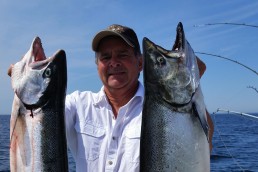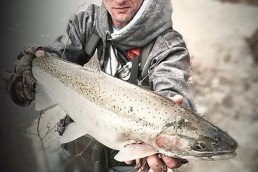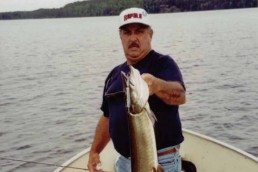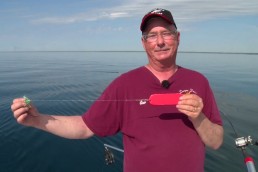Precision Cruising for Spring Steelhead Action
SHARE THIS POST
The sun was minutes away from peaking over the orange horizon. Trevor, my nephew and deckhand extraordinaire, was adjusting a port Dipsy line while I was adjusting our trolling speed and enjoying my first morning cup of coffee
“Fish on!” Trevor suddenly screamed, as the steelhead near the planer board emerged.
Steelheads are somewhat like silver torpedoes and feed near the surface most of the time. We were experiencing an extremely early spring, which means the lake will be turning over a bit earlier than usual. Turning a lake over is when the warmer bottom layer water slowly rises to the surface and the cooler surface water sinks back to the bottom.
I really enjoy fishing in May because of the aggressiveness of fish in cooler water temperatures. There’s also an abundance of fresh fish in the schools that are very active in the spring that haven’t been fooled by any artificial bait yet. The steelhead at this time can be fished at faster speeds with spoons, and the action can be quite vigorous. Being able to put a spread of Yellow Bird planer boards out with a variety of hot steelhead colors like their Warrior Lures’ Hot Banana, Orange Crush and Jelly Bean kind give me the shivers every time I see those streaking steelhead dance on the water.
Are you enjoying this post?
You can be among the first to get the latest info on where to go, what to use and how to use it!
Most steelhead are spring spawners, and this year the streams and rivers were full of these in late February. Once they completed their spring ritual, they returned to the lake to seek out food. There were a fair amount of steelhead that teased anglers trolling the shoreline for brown trout in April, but most headed deeper looking for young-of-the-year alewives and other bait. As the lake starts turning over, a large amount of bait rises to the surface with the warmer water, and with them comes these hungry steelhead.
As thermoclines begin to set up, I pay particular attention to the surface breaks. Often, a thermocline rises to the surface, and it can cause that surface to “boil.” This current created by the thermocline will gather baitfish near the surface along with the bugs other dying bait. This creates what everyone commonly calls a “scum line,” and intense breaks can be flat calm on one side of the break and a rolling boil on the other. Trolling along these “scum lines” can be productive if there is a temperature difference on the line. I like to zigzag across these lines until I can determine which side of the line holds the active fish. I have already found that both sides of the line hold active fish with one side being steelhead and the other feeding coho salmon.
While a lot of anglers like to pull flasher/fly combinations, May is when I like to run spoons. I find that I can pick up my speed and cover more ground searching for pockets of feeding steelhead with spoons, as these are more speed-forgiving lures and the steelhead are somewhat of a surface sight-feeder and aggressively attack flashing objects skimming through the top 15 feet of the water column. I prefer spoons with lots of orange, pink or red, yellow or chartreuse. On sunny days, I like the silver- backed spoons while and on cloudy darker days gold or copper work better. Also, old standbys like Slide Divers in their Watermelon and Dolphin colors are great too.
Often, these thermoclines happen over fairly deep water in the northern part of Lake Michigan around Algoma. You can get to relatively deeper water here that’s close to shore, which helps with your boat’s gas and run time.
MWO
SHARE THIS POST
Did you enjoy this post?
You can be among the first to get the latest info on where to go, what to use and how to use it!
Lee Haasch
Capt. Lee Haasch is a charter captain out of Algoma, Wis., with more than 45 years of Great Lakes angling and guiding experience. Haasch has been instructing anglers for over 30 years with education seminars and timely freelance articles.




